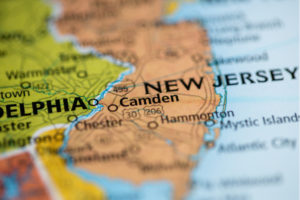Several years ago it would have been laughable to think of Camden, N.J. as a shining example of good urban policy. Camden’s homicide rate was 87 per 100,000 population, 50% above the prevailing rate in America’s most murderous large city – Baltimore.
Last year, Camden reduced its homicide rate almost two-thirds, reports Stephan J.K. Walters in NRO.
The Sacred Cow: Public Employee Unions
How did Camden achieve this? Not by defunding its police force. Instead, Camden disbanded its police force.
At the time, the cop cartel had pumped up average annual costs per officer (including extraordinarily generous fringe benefits) to $182,168. At that monopoly price, poor Camden could afford to employ just 175 cops, and during peak nighttime crime hours only a dozen might be on patrol.
But laying off the union cops and then rehiring many as county employees reduced costs to $99,605 per officer, enabling lots of new hires while keeping total expenditures roughly the same. Within a couple of years, Camden’s force exceeded 400 — a little over 50 cops per 10,000 residents, about triple the national average for similarly sized cities.
So Camden did not “abolish police,” as some of the more radical voices in the current debate claim, but actually employed more police — and more law enforcement. As the now-retired chief who led the transition explained, understaffing had made his city force a “triage unit going from emergency to emergency.” Staffing up enabled more proactive policing (including the use of some surveillance tools that civil libertarians consider problematic).
Changing the police force’s culture is a heavy lift. Union contracts prioritize job security — even of poor performers — and all but ignore organizational effectiveness, continues Mr. Walters.
Minneapolis is Exhibit A: Of 2,600 civilian complaints filed against cops since 2012, just a dozen — less than one-half of one percent — led to any form of discipline. Most were just written warnings; the harshest penalty was a one-week suspension.
Beyond policing, labor monopolies have made many public-school systems both scandalously ineffective and extraordinarily expensive. Students in strong-union states have lower proficiency rates than those in weak-union states; restrictive labor contracts have a negative impact on academic achievement, particularly for minority students. One recent study found that, nationally, this reduces graduates’ future earnings by over $200 billion annually — with the greatest effects among nonwhites.
The problem for reformers, however, is the awesome political power of these monopolies, especially in large, deep-blue cities. Given the vote blocs and money the unions wield, elected officials are loath to challenge them in any meaningful way. Until and unless they do so, the ongoing demonstrations for greater racial justice may lead to mostly symbolic change — as they have too often in the past.
Stephen J.K. Walters, chief economist at the Maryland Public Policy Institute, is the author of Boom Towns: Restoring the Urban American Dream.
Using examples from Boston, San Francisco, New Orleans, and Portland, Mr. Walters shows how a healthy respect for property rights contributed to the prosperity of American cities. The erosion of those rights helped produce the policies that bankrupted Detroit, for example, and that have led to widespread urban decline.
If you’re willing to fight for Main Street America, click here to sign up for the Richardcyoung.com free weekly email.







